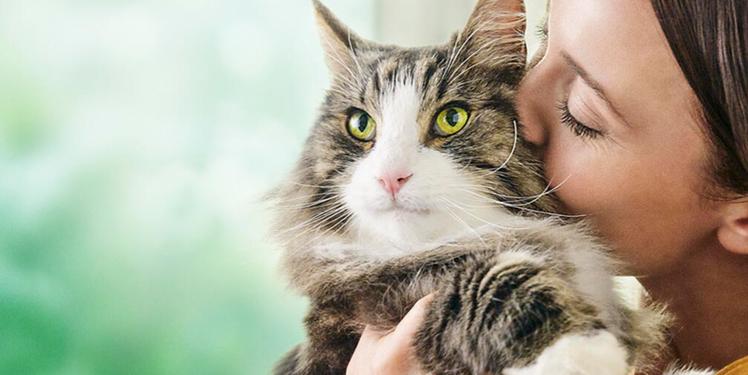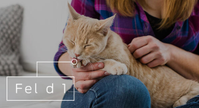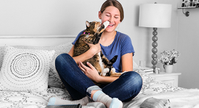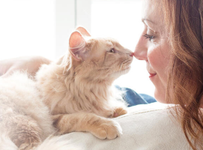
Major Breakthrough In Managing Cat Allergens
Purina scientists have found a way to safely reduce active levels of the major cat allergen found in cats’ saliva.
This can transform the way people manage cat allergens. Rather than limiting their exposure to the cat, they can limit their exposure to the allergen instead.

Dr. Ebenezer Satyaraj
Immunologist
Dr. Satyaraj is the lead investigator on the research for cat allergens.
“These allergens have created a huge barrier to cat ownership and may limit the loving interactions between cat lovers and cats.”
– Dr. Ebenezer Satyaraj
Impact Of Cat Allergens
Many people go to great lengths to reduce allergens in their environment, such as daily cleaning and frequent washing. Cat allergens can limit people’s interactions with cats, though, and they’re a common reason people relinquish cats to shelters. Allergens also create a barrier to cat adoption and ownership.

As many as 1 in 5 adults worldwide are sensitized to cat allergens.

Avoidance or rehoming is a common recommendation to manage cat allergens.
Learn More About Cat Allergens

What are Cat Allergens?
Although many people believe cat allergens stem from the cat’s hair or dander, the major cat allergen is Fel d 1. This protein is found primarily in the cat’s saliva.
Fel d 1 is then transferred to the cat’s hair and skin during grooming. As the cat sheds, the allergen on the hair is dispersed throughout the home.

What about Hypoallergenic Cats?
Contrary to popular belief, there are no truly hypoallergenic cats. All cats—even hairless ones—produce Fel d 1, regardless of breed, age, sex or neuter status.
Additionally, Fel d 1 levels are not affected by hair color or length.
Fel d 1: The Major Cat Allergen
[Fel • Dee • One] noun
A protein produced in a cat’s salivary and sebaceous (skin) glands. Transferred to cat’s hair and skin during grooming. Dispersed in the environment via hair and dander (dried flakes of skin).

A Revolutionary, Feline-Friendly Way To Manage Cat Allergens
After more than 10 years of research, Purina scientists discovered the primary cat allergen can be reduced when cats eat a diet containing a specific protein found in eggs.
This protein safely binds and blocks Fel d 1 in cats’ saliva and this inactive Fel d 1 gets transferred to the hair when grooming. This is a safe, feline-friendly approach and does not interfere with with Fel d 1 production or change the cats’ overall physiology.

According To A Landmark Purina Study
Of cats fed this egg ingredient, 97% showed decreased levels of active Fel d 1 on their hair and dander. On average, there was a 47% reduction of active Fel d 1 on cats’ hair beginning with the third week of feeding the diet.

The decrease in active Fel d 1 on cats’ hair and dander can help reduce cat allergens shed into the environment.

Purina Pro Plan LiveClear Allergen Reducing Cat Food
The revolutionary cat food shown to reduce the major allergen in cat hair and dander by an average of 47% starting in the third week of daily feeding.

Sensitive To Cat Allergens? Take The Liveclear Challenge
Purina Pro Plan LiveClear is the first and only cat food shown to reduce the major allergen in cat hair and dander by an average of 47% starting in the third week of daily feeding. Take The LiveClear Challenge and discover the freedom you – and your cat – could have by this time next month.
“Our discovery has the potential to transform how people manage cat allergens.”
— Dr. Ebenezer Satyaraj
Stay in Touch
Sign up today! From training tips to special offers, get the tools you need to keep your pet happy and healthy.
